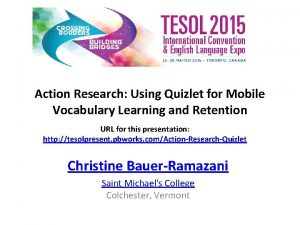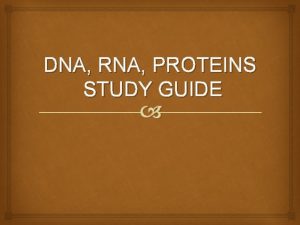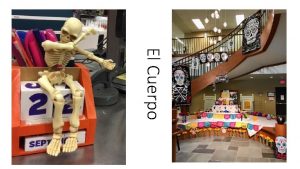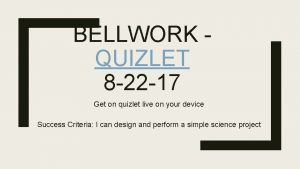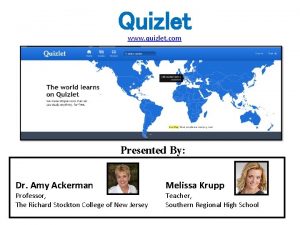DNA and its Structure Study Quizlet QUIZ TODAY
















- Slides: 16

DNA and its Structure

Study Quizlet! • QUIZ TODAY!

Vocabulary 1. 2. 3. 4. 5. 6. 7. 8. Nucleotide Deoxyribose Nitrogenous base Purine Pyrimidine Base-pairing rules Complementary Base pair Base Sequence

The Structure of DNA (Deoxyribonucleic acid) Where is DNA found? – Eukaryotes: nucleus, chromosomes – Prokaryotes: cytoplasm • DNA is a polymer made up of many repeating single units (monomers) These monomers are called nucleotides • Each nucleotide is made up of three things: – 5 -carbon sugar (deoxyribose) – Phosphate group – Nitrogenous base • The “backbone” of DNA molecules is made of phosphate and sugar

Four Nitrogenous Bases • Adenine (A) • Guanine (G) • Cytosine (C) • Thymine (T) • Chargaff’s Rule: Organisms should have 1: 1 ratio purines and pyrimidines(base pair rule) A=T and G=C

The Double Helix • 1950’s Rosalind Franklin used X-ray diffraction to study DNA • Credit for the double helix was given to James Watson and Francis Crick • Only Watson and Crick received the Nobel Prize in 1962.

• The DNA molecule appears as a “twisted ladder” • This shape is referred to as a double helix The phosphates and the sugars form the “handrails” of the helix with covalent bonds, and the hydrogen bonds are in the “steps” of the DNA helix.


Why is complementary base pairing important? 1) Hydrogen bonds between the base pairs hel hold the two strands together. 2) The complementary nature of DNA helps explain how DNA replicates before a cell divides.

Video Anti-parallel strands We refer to DNA as being anti-parallel because the sides of the DNA are going in opposite directions. • One side is travelling 5’ to 3’ 5 3 3 5 While the other side is travelling 3’ to 5’.

• Looking within the sugars you can see there is an intrinsic difference between the two strands. • Top strand is a 5’ carbon of each sugar is on the left and the 3’ carbon the right. Thus, it moves left to right 5’ to 3’ Bottom strand is opposite. It moves 3’ 5’

Nitrogenous Bases


DNA vs. RNA DRAW DNA RNA Sugar = deoxyribose Sugar = ribose Double-stranded molecule Single-stranded molecule Thymine bonds with adenine Uracil instead of thymine

Elbow Partner Group Work 1. Use the base-pairing rules to determine the base sequence that is complementary to the sequence below C-G-A-T-T-G 2. Distinguish between purines and pyrimidines. 3. A plant’s DNA has nucleotides that are 20% thymine. What percentage of guanine would be present?

Homework: 1. What piece of information did Rosalind Franklin have that helped Watson and Crick determine the double helix structure of DNA? 2. Name three parts of a nucleotide. 3. Summarize the locations of covalent bonds and hydrogen bonds in a DNA molecule. 4. Describe why the two strands of the double helix are considered to be complementary. 5. State the base-paring rule in DNA. 6. How do the base-pairing rules relate to the structure of DNA?
 Quiz quizlet
Quiz quizlet Coding dna and non coding dna
Coding dna and non coding dna For todays meeting
For todays meeting In todays lesson
In todays lesson Proposal kickoff meeting agenda
Proposal kickoff meeting agenda Fingerprint galton details
Fingerprint galton details Today's lesson or today lesson
Today's lesson or today lesson Example of repitition
Example of repitition Ap psychology module 2 review
Ap psychology module 2 review Replication
Replication Bioflix activity dna replication dna replication diagram
Bioflix activity dna replication dna replication diagram Enzyme involved in dna replication
Enzyme involved in dna replication Chapter 11 dna and genes
Chapter 11 dna and genes Dna rna and proteins study guide answers
Dna rna and proteins study guide answers Rna and protein synthesis study guide
Rna and protein synthesis study guide No quiz today
No quiz today No quiz today
No quiz today
